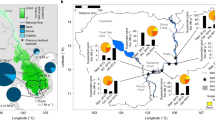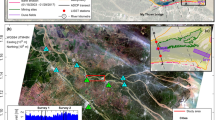Abstract
The Mississippi River delta is undergoing a catastrophic drowning, whereby 5,000 km2 of low-lying wetlands have converted to open water over at least the past eight decades1, as a result of many anthropogenic and natural factors1,2,3. Continued net land loss has been thought inevitable due to a decline in the load of total suspended sediment—both sand and mud—carried by the river4. However, sand—which accounts for ~50–70% of modern and ancient Mississippi delta deposits5,6 but comprises only ~20% of the sampled portion of the total load3—could be more important than mud for subaerial delta growth5. Historically, half of the Mississippi River sediment load is supplied by the Missouri River3. Here we analyse suspended sediment load data from two locations downstream from the lowest Missouri River dam to show that the measured sand load in the lower 1,100 km of the Mississippi River has not significantly diminished since dam construction. A one-dimensional numerical model of river morphodynamics predicts that the sand load feeding the delta will decrease only gradually over the next several centuries, with an estimated decline from current values of no more than about 17% within the coming six centuries. We conclude that the lower Mississippi River channel holds a significant reservoir of sand that is available to replenish diminished loads via bed scour and substantially mitigate land loss.
This is a preview of subscription content, access via your institution
Access options
Subscribe to this journal
Receive 12 print issues and online access
$259.00 per year
only $21.58 per issue
Buy this article
- Purchase on Springer Link
- Instant access to full article PDF
Prices may be subject to local taxes which are calculated during checkout




Similar content being viewed by others
References
Walker, H. J., Coleman, J. M., Roberts, H. H. & Tye, R. S. Wetland Loss in Louisiana. Geografiska Annaler 69A, 189–200 (1987).
Morton, R. A. & Bernier, J. C. Recent subsidence-rate reductions in the Mississippi Delta and their geological implications. J. Coast. Res. 26, 555–561 (2010).
Meade, R. H. & Moody, J. A. Causes for the decline of suspended-sediment discharge in the Mississippi River system, 1940–2007. Hydrol. Process 24, 35–49 (2010).
Blum, M. D. & Roberts, H. H. Drowning of the Mississippi delta due to insufficient sediment supply and global sea-level rise. Nature Geosci. 2, 488–491 (2009).
Roberts, H. H., Coleman, J. M., Bentley, S. J. & Walker, N. An embryonic major delta lobe: A new generation of delta studies in the Atchafalaya–Wax Lake Delta system. Gulf Coast Assoc. Geol. Soc. Trans. 53, 690–703 (2003).
Mohrig, D. & Armstrong, C. Building the coastline: Linking study of the modern and ancient depositional environments to predict the response of Mississippi River delta to environmental change. AGU (Fall Meeting Suppl.) abstr. EP43D-1491680 (2012)
American Association of Port Authorities. World Port Rankings (2008); http://www.aapa-ports.org/Industry/content.cfm?ItemNumber=900&navItemNumber=551
State of Louisiana Final Louisiana 2012 Master Plan Report (2012); http://www.coastalmasterplan.louisiana.gov/2012-master-plan/final-master-plan/
Lorenzo-Trueba, J. et al. Exploring the role of organic matter accumulation on delta evolution. J. Geophys. Res. 117, 1–12 (2012).
Wilson, C. A. & Allison, M. A. Sediment dynamics and geomorphology of eroding marsh shorelines in southeastern Louisiana. Estuar. Coast Shelf S. 80, 483–494 (2008).
Nepf, H. M. Ecogeomorphology of Tidal Marshes 137–163 (American Geophysical Union, (2004).
Baumann, R. H., Day, J. W. & Miller, C. A. Mississippi deltaic wetland survival: Sedimentation versus coastal submergence. Science 224, 1093–1095 (1984).
Kenney, M. A. et al. Cost analysis of water and sediment diversions to optimize land building in the Mississippi River delta. Wat. Resour. Res. 49, 3388–3405 (2013).
Kim, W., Mohrig, D., Twilley, R., Paola, C. & Parker, G. Is it feasible to build new land in the Mississippi River Delta? Eos Trans. AGU 90, 373–374 (2009).
Paola, C. et al. Natural processes in delta restoration: Application to the Mississippi Delta. Annu. Rev. Mar. Sci. 3, 67–91 (2011).
Day, G., Dietrich, W. E., Rowland, J. C. & Marshall, A. The depositional web on the floodplain of the Fly River, Papua New Guinea. J. Geophys. Res. 113, 1–19 (2008).
Nittrouer, J. A., Mohrig, D. & Allison, M.A. Punctuated sand transport in the lowermost Mississippi River. J. Geophys. Res. 116, 1–24 (2011).
Nittrouer, J. A., Shaw, J., Lamb, M. P. & Mohrig, D. Spatial and temporal trends for water-flow velocity and bed-material sediment transport in the lower Mississippi River. Geol. Soc. Am. Bull. 124, 400–414 (2012).
Nittrouer, J. A. et al. Mitigating land loss in coastal Louisiana by controlled diversion of Mississippi River sand. Nature Geosci. 5, 534–537 (2012).
Horowitz, A. J., Elrick, K. A. & Smith, J. J. Annual suspended sediment and trace element fluxes in the Mississippi, Columbia, Colorado, and Rio Grande drainage basins. Hydrol. Process 15, 1169–1207 (2001).
Saucier, R. T. Geomorphology and Quaternary Geologic History of the Lower Mississippi Valley (US Army Corps of Engineers, (1994).
Edmonds, D. A. Stability of backwater-influenced river bifurcations: A study of the Mississippi–Atchafalaya system. Geophys. Res. Lett. 39, 1–5 (2012).
Fisk, H. N. Geological Investigation of the Alluvial Valley of the Lower Mississippi River (Mississippi River Commission, (1944).
National Resources Conservation Service. Phase II Sedimentation Assessment for the Upper Missouri River Basin: Assessment Report. Report available at: http://www.msaconline.com/Missouri%20River%20Phase%20II%20%20Report.pdf Prepared by the United States Department of Agriculture, Natural Resources Conservation Service, in consultation with the US Army Corps of Engineers and the US Geological Survey. 51 (2009)
Smith, N. D. & Perez-Arlucea, M. Natural levee deposition during the 2005 flood of the Saskatchewan River. Geomorphology 101, 583–594 (2008).
Nittrouer, J. A., Mohrig, D., Allison, M. A. & Peyret, A. B. The lowermost Mississippi River: A mixed bedrock-alluvial channel. Sedimentology 58, 1914–1934 (2011).
Nittrouer, J. A., Allison, M. A. & Campanella, R. Bedform transport rates for the lowermost Mississippi River. J. Geophys. Res. 113, 1–16 (2008).
Lauer, J. W. & Parker, G. Net local removal of floodplain sediment by river meander migration. Geomorphology 96, 123–149 (2008).
Syvitski, J. P. M. et al. Sinking deltas due to human activities. Nature Geosci. 2, 681–686 (2009).
Kolker, A. S., Allison, M. A. & Hameedj, S. An evaluation of subsidence rates and sea-level variability in the northern Gulf of Mexico. Geophys. Res. Lett. 38, 1–6 (2011).
Acknowledgements
This research represents a contribution to the Mississippi Wetlands restoration effort of the National Center for Earth-surface Dynamics, a Science and Technology Center of the US National Science Foundation. We thank Gary Parker and Eric Prokocki for help and support. Brandon McElroy is also thanked for his support. We also thank Charlie Hager and Alex Nettles for helping organize the data from Thebes and Tarbert Landing.
Author information
Authors and Affiliations
Contributions
J.A.N. processed the USGS data, constructed the model and was the lead author of the manuscript; E.V. processed the USGS data, constructed the model and provided significant editorial feedback on the manuscript.
Corresponding author
Ethics declarations
Competing interests
The authors declare no competing financial interests.
Supplementary information
Supplementary Information
Supplementary Information (PDF 3892 kb)
Rights and permissions
About this article
Cite this article
Nittrouer, J., Viparelli, E. Sand as a stable and sustainable resource for nourishing the Mississippi River delta. Nature Geosci 7, 350–354 (2014). https://doi.org/10.1038/ngeo2142
Received:
Accepted:
Published:
Issue Date:
DOI: https://doi.org/10.1038/ngeo2142
This article is cited by
-
Critical threshold of periodic point bar scour and sediment body transport path in tidal reaches: A case study of Fujiangsha reach, Yangtze River
Journal of Geographical Sciences (2023)
-
Sediment and Nutrient Trapping by River Dams: A Critical Review Based on 15-Year Big Data
Current Pollution Reports (2023)
-
A Comprehensive Assessment of Sediment Dynamics in the Barataria Basin (LA, USA) Distinguishes Riverine Advection from Wave Resuspension and Identifies the Gulf Intracoastal Waterway as a Major Sediment Source
Estuaries and Coasts (2022)
-
Redirecting sediment and rearranging social justice
Water History (2021)
-
River bank instability from unsustainable sand mining in the lower Mekong River
Nature Sustainability (2020)



